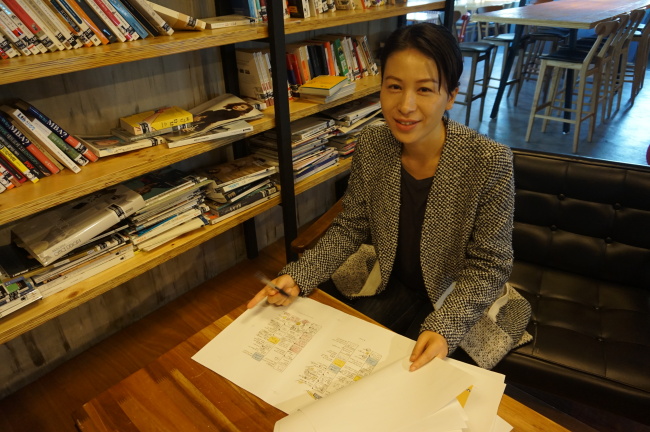[Weekender] Visual thinking pioneer stresses the power of drawing
By Korea HeraldPublished : Nov. 14, 2014 - 21:38
On Eun-ju, CEO of Social Frog, a South Korean start-up, was quick to name names that could help explain her specialty: Einstein, Da Vinci, Picasso and Jobs.
She told The Korea Herald that she grouped these figures together because they represent the power of drawing.
Though how much drawing played a part is arguable, it is widely thought that Einstein used visualization to come up with his theory of relativity. The same is true of Leonardo Da Vinci, an artistic genius who was also an expert engineer, drawing up creations including the helical rotor, a blueprint for a flying machine.
Picasso was also known to use pictures during especially grueling brainstorming sessions. Steve Jobs was a master of visual presentation.
The list could go on, but she shifted the focus to South Korea, a country that President Park Geun-hye claims should nurture a “creative economy.” On said, unfortunately, South Koreans appear to be overly averse to drawing, even though the technique is increasingly useful in dealing with the flow of complex and fragmented information through various platforms including social media.
She told The Korea Herald that she grouped these figures together because they represent the power of drawing.
Though how much drawing played a part is arguable, it is widely thought that Einstein used visualization to come up with his theory of relativity. The same is true of Leonardo Da Vinci, an artistic genius who was also an expert engineer, drawing up creations including the helical rotor, a blueprint for a flying machine.
Picasso was also known to use pictures during especially grueling brainstorming sessions. Steve Jobs was a master of visual presentation.
The list could go on, but she shifted the focus to South Korea, a country that President Park Geun-hye claims should nurture a “creative economy.” On said, unfortunately, South Koreans appear to be overly averse to drawing, even though the technique is increasingly useful in dealing with the flow of complex and fragmented information through various platforms including social media.

On’s advice is simple: “We have to start drawing.”
Social Frog, led by On, aims to “propagate the hidden wisdom” in visual thinking across Korea, offering classes in visual thinking in schools, corporations and other individual members interested in the much-coveted skills in the age of digital convergence and creativity-led business startups.
In doodling, age does not matter. The company’s customers are as young as 3 and as old as 75.
“Drawing helps us use both sides of our brains,” On said. “By using both sides of our brains, we can come up with new ideas that can create enormous opportunities.”
The human brain is divided into left and right hemispheres. The left is said to deal with reasoning, while the right leads emotional thought processes. Drawing, according to some scientists, stimulates the right side of the brain, a part of the body that On says we are not using enough.
“I’m not talking about drawing on huge canvasses. Most of us will benefit by scribbling into small notebooks, or personal diaries.”
She carries a scheduler where she draws small caricatures of people she meets for the first time. In another notebook, she also draws pictures to help her analyze her own self.
“A while back, I had felt that I had so much clothing, but nothing to wear to the office every day,” she said. “I decided to draw small pictures of all my dresses. Next to each picture, I jotted down the reasons I either wore the particular dress frequently, or the reasons I chose not to don the dresses too many times.”
Once she did this, On knew which dress to throw away and which ones to keep. The quick 10-minute visual thinking process helped her improve a small part of her life. She could go shopping more efficiently because she knew better what kind of clothing she preferred. She could also spend less time in the morning ruminating over what to wear.
Visual thinking, On said, can help people learn foreign languages as well.
“I would like to especially recommend visual thinking to expats in Korea trying to learn Korean. Associating particular words with illustrations, and certain situations help us better remember them,” she said.
Rote memorization of new words and their definitions won’t get students very far, according to On. The advocate of visual thinking, a field that is just starting to grow in Korea, suggested that learners should toy with a simple stick-and-figure picture to go along with a new word they are trying to learn.
On likes to think of herself as the Christopher Columbus of visual thinking in Korea.
“When Columbus set out to look for the Indies, everybody in Europe doubted the man,” she said. Such doubt turned into admiration when he discovered the New World. Just like the 15th-century explorer, On said she wanted to help Koreans reevaluate the potential of drawing in various fields.
“I never seriously studied the arts or drawing. I sincerely believe anyone can do this,” she said.
By Jeong Hunny (hj257@heraldcorp.com)
-
Articles by Korea Herald



![[AtoZ into Korean mind] Humor in Korea: Navigating the line between what's funny and not](http://res.heraldm.com/phpwas/restmb_idxmake.php?idx=644&simg=/content/image/2024/04/22/20240422050642_0.jpg&u=)
![[Exclusive] Korean military set to ban iPhones over 'security' concerns](http://res.heraldm.com/phpwas/restmb_idxmake.php?idx=644&simg=/content/image/2024/04/23/20240423050599_0.jpg&u=20240423183955)



![[Graphic News] 77% of young Koreans still financially dependent](http://res.heraldm.com/phpwas/restmb_idxmake.php?idx=644&simg=/content/image/2024/04/22/20240422050762_0.gif&u=)
![[Herald Interview] Why Toss invited hackers to penetrate its system](http://res.heraldm.com/phpwas/restmb_idxmake.php?idx=644&simg=/content/image/2024/04/22/20240422050569_0.jpg&u=20240422150649)






![[Exclusive] Korean military to ban iPhones over security issues](http://res.heraldm.com/phpwas/restmb_idxmake.php?idx=652&simg=/content/image/2024/04/23/20240423050599_0.jpg&u=20240423183955)



![[Today’s K-pop] Ateez confirms US tour details](http://res.heraldm.com/phpwas/restmb_idxmake.php?idx=642&simg=/content/image/2024/04/23/20240423050700_0.jpg&u=)